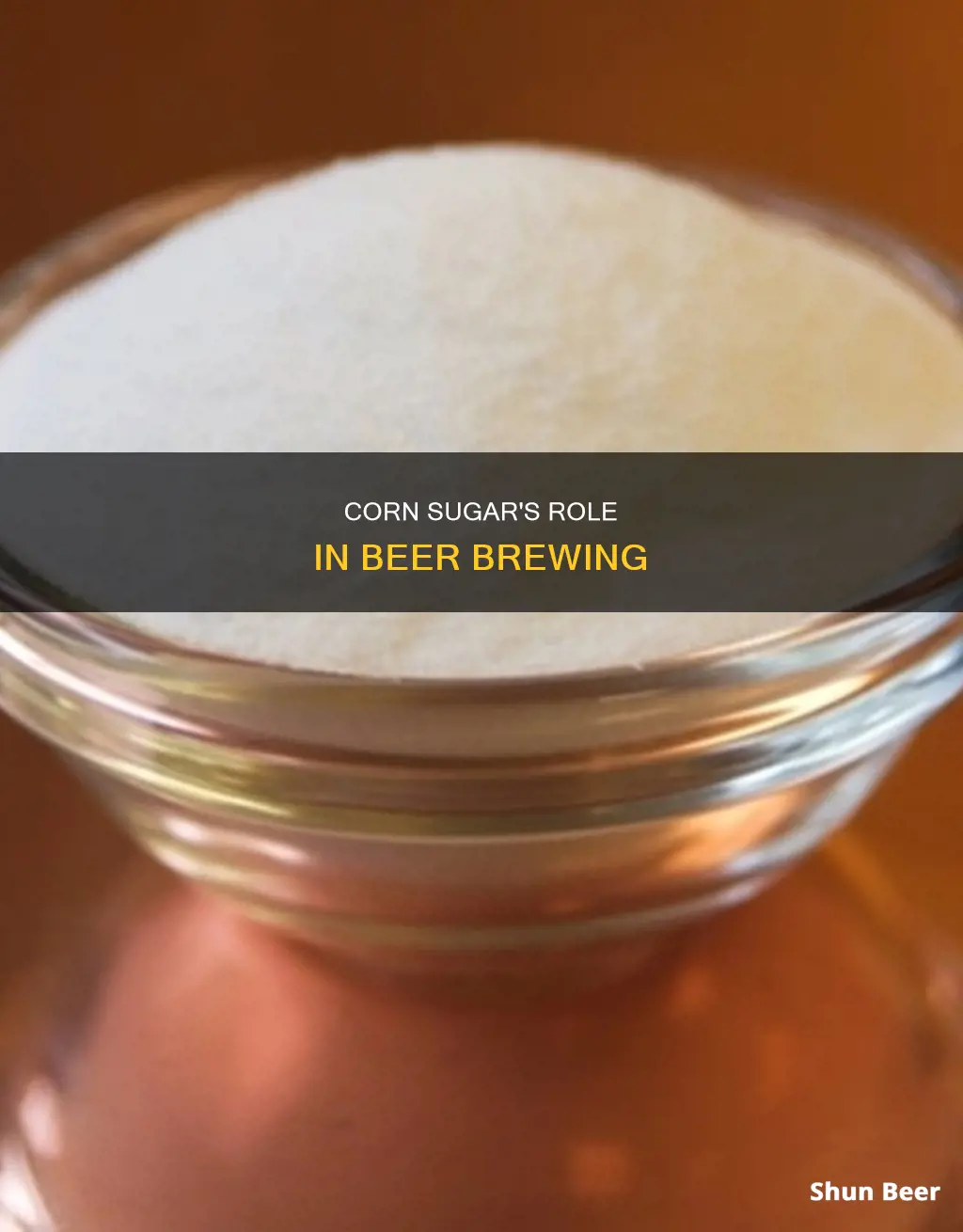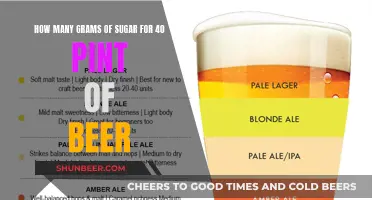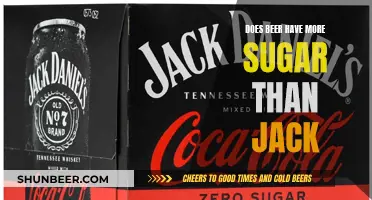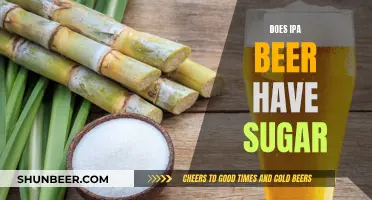
Corn sugar, also known as dextrose or priming sugar, is used in the brewing process to prime or add fermentables to beer. It is added to beer to increase carbonation, as yeast consumes the sugar and converts it into CO2, giving beer its carbonation. Corn sugar is also used to lighten the body and dry out beers, which can be used to increase the alcohol content in lighter-coloured beer styles such as cream ales, pale ales and IPAs without adding to the body or mouthfeel. It is also flavourless and will not impact the flavour of the final product.
| Characteristics | Values |
|---|---|
| Other names | Dextrose, priming sugar |
| Composition | 95% solid, 99% of which is glucose |
| Fermentability | 100% |
| Uses | Priming, bottle conditioning, boosting ABV, lightening body, drying out |
| Rate of use | 1 oz. per gallon of beer or 5 oz. per 5-gallon batch |
What You'll Learn

Corn sugar is used to make a priming solution for bottling beer
Corn sugar is a versatile ingredient in the process of brewing beer. It is also known as dextrose or priming sugar and is used to prime or add fermentables to beer. Corn sugar is highly refined and does not contain any corn character. It is also flavourless and will not impact the flavour of the final product.
The amount of corn sugar used will depend on the desired level of carbonation. As a general guideline, it is recommended to use 1 ounce of corn sugar per gallon of beer (or 5 ounces per 5-gallon batch, which is about 3/4 cup). This amount of corn sugar will produce around 2.5 volumes of carbon dioxide in the beer, which is typical for most American and European pale ales.
In addition to its role in carbonation, corn sugar can also be used to adjust the alcohol content and body of the beer. Corn sugar can increase the alcohol content while reducing the body of the beer, making it ideal for high-gravity beers such as Belgian ales or Double IPAs. It lightens the body and dries out the beer, allowing for a higher alcohol content in lighter-coloured beers such as cream ales, pale ales, and IPAs without adding to the body or mouthfeel.
Best Low-Sugar Beers: Enjoy Guilt-Free Sipping
You may want to see also

It produces CO2 in the bottle, giving beer its carbonation
Corn sugar is used in the process of priming beer, which is a vital step in the creation of carbonation. Carbonation is what gives beer its fizz and is a result of the conversion of corn sugar into carbon dioxide. This process occurs after the beer has been bottled and the yeast has begun to break down the sugars. The carbon dioxide is then trapped within the bottle, creating the desired level of carbonation.
The priming process involves making a priming solution by dissolving corn sugar in water and then adding this solution to the beer before bottling. Corn sugar is ideal for this process as it is highly refined and does not affect the flavour of the beer. It is also easily broken down by yeast, making it 100% fermentable. This high level of fermentability means that the yeast can efficiently convert the corn sugar into carbon dioxide, creating the desired level of carbonation.
The amount of corn sugar used in the priming process is important, as too much can result in an over-carbonated beer. A general rule is to use one ounce of corn sugar per gallon of beer, or about 3/4 cup of corn sugar for a 5-gallon batch. This amount can be adjusted depending on the desired level of carbonation, with more corn sugar resulting in higher carbonation levels.
The priming process is crucial in creating the carbonation that gives beer its characteristic fizz. Corn sugar is an ideal sugar for this process due to its high fermentability, ease of use, and neutral flavour. By following the correct process and using the appropriate amount of corn sugar, brewers can create a beer with the desired level of carbonation.
Michelob Ultra Beer: Sugar Content and Health
You may want to see also

Corn sugar can be used to boost the ABV of beer
Corn sugar, also known as dextrose or priming sugar, is a versatile ingredient in the beer-making process. While it is commonly used for priming or carbonating beer, it can also be added to the brew to increase the alcohol content.
During fermentation, yeast consumes sugar and converts it into alcohol (ethanol) and carbon dioxide. Corn sugar is 95% solid, and of those solids, 99% is pure glucose, which is the preferred food source for yeast. This means that by adding corn sugar to the wort, brewers can increase the amount of fuel available for the yeast to convert into alcohol, resulting in a higher ABV (alcohol by volume).
Additionally, corn sugar is flavourless and does not impact the flavour profile of the final product. It also contributes to a thinner mouthfeel, making it ideal for light-coloured beer styles such as cream ales, pale ales, and IPAs.
When using corn sugar to boost ABV, it is important to use it in moderation. Adding too much corn sugar can result in an overly lively beer when bottle conditioning or can prevent some of the other sugars from fermenting, leading to a stuck fermentation. As a general guideline, it is recommended to use one ounce of corn sugar per gallon of beer.
It is also crucial to sanitise the corn sugar before adding it to the brew to eliminate any traces of contaminants or bacteria that could spoil the beer. This can be done by boiling the corn sugar in water prior to adding it to the mixture.
By understanding the role of corn sugar in boosting ABV and following the recommended usage tips, brewers can effectively increase the alcohol content in their beers without compromising the desired flavour and mouthfeel.
Wheat Beer's Sweet Secret: Sugar Content Explained
You may want to see also

It can be used to lighten the body of beer
Corn sugar, also known as dextrose or priming sugar, is a common ingredient in beer brewing. One of its functions is to lighten the body of the beer, creating a lighter and more drinkable brew. This is achieved by adding corn sugar to the boil, which reduces the body and mouthfeel of the beer.
The addition of corn sugar also boosts alcohol content without adding to the beer's body or mouthfeel. This makes it ideal for lighter-coloured beer styles such as cream ales, pale ales, and IPAs. Corn sugar is highly fermentable, with 42 gravity points per pound per gallon (PPG) and 100% fermentability. This means that yeast can easily convert it into alcohol, lightening the body of the beer.
The use of corn sugar in brewing also has other advantages. It is a classic sugar used in priming beer, giving consistent carbonation without greatly affecting the flavour. Corn sugar is also easy to use, affordable, and highly fermentable. It dissolves quickly and easily in water, ensuring even distribution throughout the wort and helping to prevent inconsistencies in the fermentation process.
When compared to other sugars used in brewing, such as cane sugar, corn sugar has a faster fermentation rate due to its monosaccharide composition. It is also flavourless, which can be advantageous for brewers who desire a more neutral taste profile.
By understanding the properties of corn sugar and its impact on beer, brewers can create beers with the desired body, flavour, and alcohol content. Corn sugar is a versatile tool in the brewer's arsenal, allowing for the creation of light and drinkable beers with enhanced alcohol content.
Beer and Sugar: What's the Connection?
You may want to see also

Corn sugar is also known as dextrose or priming sugar
Dextrose is a monosaccharide, a single molecule consisting of six carbon atoms. It is also known as glucose, blood sugar or corn sugar. It is a simple sugar, and so dissolves quickly and easily in water, ensuring even distribution throughout the wort. This helps to prevent inconsistencies in the fermentation process and ensures that the finished product has a consistent flavour profile.
Corn sugar is highly refined and does not contain any corn character. Brewers seeking a corn-like character, for example in a classic American Pilsner, need to cook and mash corn grits as part of an all-grain recipe.
Corn sugar is used to prime or add fermentables to beer, wine, cider or other drinks. It is used at a rate of 1oz per gallon of beer (or 5oz per 5-gallon batch, about 3/4 of a cup) to prime beer for bottling. It can be used to lighten the body and dry out beers, so it can be used to increase alcohol content in lighter-coloured beer styles such as cream ales, pale ales and IPAs without adding to the body or mouthfeel.
Roughly 3.4oz of corn sugar per gallon will boost ABV by 1%.
Abita Beer: Sugar Content and Nutritional Facts
You may want to see also
Frequently asked questions
Corn sugar, also known as dextrose or priming sugar, is used to prime or add fermentables to beer. It is the most common sugar used in priming beer and gives consistent carbonation without greatly affecting flavour.
Cane sugar is made of sucrose, whereas corn sugar is made of dextrose (glucose). Cane sugar is a disaccharide, meaning it has two sugar molecules, whereas corn sugar is a monosaccharide, meaning it has one. This means that yeast takes longer to break down cane sugar, and it can therefore impart more flavour to the beer. Cane sugar also yields more gravity per gallon than corn sugar.
Corn sugar is the best sugar for bottle-conditioned beers as it adds natural carbonation. It also doesn't add sweetness to the beer, and it can raise the alcohol level while reducing the body, making it ideal for high-gravity beers such as Belgian ales or double IPAs. It can also be used as a sugar wash due to its neutral flavour. Corn sugar is also highly refined, affordable, and easy to dissolve in water.
Corn sugar may not add much flavour complexity to the beer, and it can contribute to a thinner mouthfeel.
It is recommended to use 1 oz. of corn sugar per gallon of beer (or 5 oz. per 5-gallon batch, about 3/4 cup).







